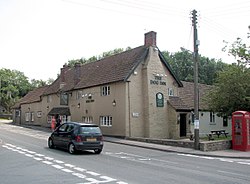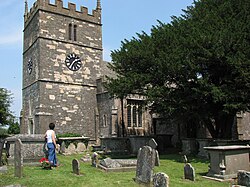Old Sodbury
| Old Sodbury | |
| Gloucestershire | |
|---|---|
 The Dog Inn, Old Sodbury | |
| Location | |
| Grid reference: | ST726822 |
| Location: | 51°32’1"N, 2°21’22"W |
| Data | |
| Population: | 661 (2011) |
| Post town: | Bristol |
| Postcode: | BS37 |
| Dialling code: | 01454 |
| Local Government | |
| Council: | South Gloucestershire |
| Parliamentary constituency: |
Northavon |
Old Sodbury is a small village in the valley of the River Frome just below and to the west of the Cotswold escarpment and to the east of Chipping Sodbury and Yate in south-western Gloucestershire, in the Grumbald's Ash Hundred.
The village extends from Chipping Sodbury in the West to the Cotswold Edge in the east and is on the Cotswold Way. The Badminton Road (A432) winds eastwards towards Badminton through the village, up to the Cross Hands junction with the A46, which runs along the top of the Cotswold escarpment from Bath to Stroud.
The village lies on an old coaching route, and is much more ancient than its westerly neighbour, Chipping Sodbury: hence the name 'Old' Sodbury.
Name
File:OldSodbury2.webm The name of the village is recorded in Old English language (in the dative case) as Soppanbyrig, meaning "Soppa's fort" (or 'town') and in Domesday Book as Sopeberie. The name may refer to the Iron Age hillfort just to the north-east of the village.
Hill fort
The hill fort, perched on the edge of the Cotswold escarpment, is enclosed on three sides by two parallel earthworks, and is open to the west, commanding an impressive view of the Frome Valley, Severn Vale and the Welsh mountains. The earthen walls enclose an area of eleven acres. They are usually kept mown by the local farmer: the fort is on private land, but accessible.
The fort can be reached by footpath from the A46 road, and through the village from below by the Cotswold Way. Below the fort is a group of ancient pillow mounds which are supposed to have been created by a landowner as rabbit warrens to supply meat.
The Romans strengthened the fort for use as a camp to support their western frontier. In AD 577 the Saxon army used the fort as a camp before the Battle of Dyrham, a few miles to the south.
History
The hill fort above Sodbury was create in the Iron Age, and was reused at times by the Romans. In 577, during the Saxon Conquest, the Gewisse, or West Saxons, camped at Sodbury before marching south to battle at Dyrham.
Bishop Milred (743–755) granted the land at Soppenbyrig to Eanbald, who passed it to Eastmund, on condition that there be a man in Holy Orders, and worthy of them, in their family; but if otherwise, the lands would pass back to the See of Worcester. In 888 the covenant failed; however, the land was granted to Eadnoth in perpetuity for the rent of 15 shillings, payable to the See of Worcester yearly at Tetbury.
In Edward the Confessor's reign, the manor formed part of the estate of Brictric, Earl of Gloucester.
King Edward IV camped here in 1471 before attacking the army of Margaret of Anjou at the Battle of Tewkesbury.
Church
The Church of Saint John the Baptist is late Norman or Transitional, and is some 900 years old. It has two effigies of knights: one is late 14th century, carved in wood; and the other is dated to 1240, carved in stone, featuring a very large shield. These two are considered to have been lords of the local manor.
The church is of late Norman period, and although it has been much enlarged and altered, much of the original work remains. In the nave there is an arcade of Normal columns, there are two Norman windows and the tower is also Norman.
In the churchyard at Old Sodbury is a number of old bale-tombs; these were tombs for rich merchants. Some of the gravestones date back to the early 19th century. Just outside the churchyard on the hillside is a topograph (a large stone with an engraving), installed to commemorate the second millennium, that shows Old Sodbury in relation to its geographical surroundings.
Other buildings
There are two primary schools (Old Sodbury CofE Primary School, and the privately run Overndale School), two hotels, and two pubs, The Bell Hotel and The Dog Inn. The village has a petrol station, a football pitch and a playground, but no longer a post office since the round of closures in 2008. The village shop soldiered on in the same premises on the Badminton Road for another three years, but finally closed in 2011. The historic Cross Hands Hotel stands on the North-Eastern corner of the A46 crossroads, and there is a farm shop (Cotswold Edge) opposite the hotel.
There is a crenellated tower resembling a rook chess piece on the escarpment immediately above and to the East of the village, visible from the main road. It performs the function of a ventilation shaft (the first of six) for the Chipping Sodbury Tunnel on the main railway line from Glamorgan, via Bristol Parkway to London Paddington. This line was opened in 1903 as part of the Great Western Railway, which runs through the village and under the hill above it. Trains used to stop at Chipping Sodbury and Badminton stations, which were closed following the Beeching cuts. The nearest station is now Yate on the main line from Bristol Temple Meads to Birmingham New Street, which crosses the former Great Western Railway to the South of Yate.
Lyegrove House, one mile east of the village just off the B4040 road to Badminton, is 17th century in origin, altered in the 19th and 20th centuries. The Gothic style Lodge was built in 1835 and designed by Charles Dyer of Bristol. In 1927, the Countess of Westmorland contracted George Herbert Kitchin (1870-1951) to restore the house and lay out the formal gardens. Other examples, of Kitchin's designs are Compton End, Winchester, and Horsley Hall, Gresford.[1]
Outside links
| ("Wikimedia Commons" has material about Old Sodbury) |
- Old Sodbury Village Hall
- Sodbury Players amateur dramatics group
References
- ↑ George Herbert Kitchin: Parks and Gardens
- Nikolaus Pevsner: Pevsner Architectural Guides
- Fox, Francis Fredrick: 'The History of the Parishes of Old Sodbury and of Little Sodbury, and of the Town of Chipping Sodbury in the County of Gloucester' (1907) ISBN 1120035031
- Couzens: P.A.:
- 'Annals of Two Manors - viz Old Sodbury and of Little Sodbury'
- 'Annals of a Borough - viz Chipping Sodbury' (1989)
